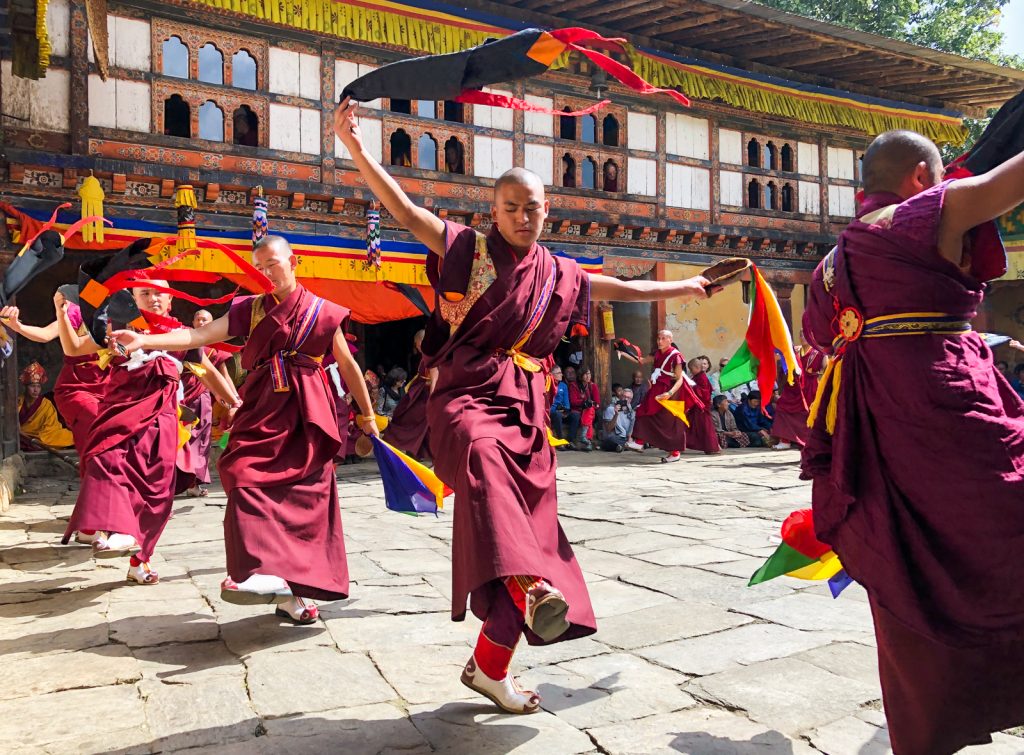Every year, Tamzhing Monastery in Bhutan hosts a display of Buddhist dances and cultural expressions that were “discovered,” taught, recorded, and practiced by the great Bhutanese lama Pema Lingpa (1450-1521), the Himalayan kingdom’s homegrown religious visionary and prolific treasure revealer, or terton. Through his amassed treasure teachings and his own compositions, Pema Lingpa shaped Bhutanese cultural and spiritual life, contributing prayers and practices deeply embedded in the country’s religious ecosystem. The most public and visible aspect of his legacy? The repertoire of cham (sacred dances) attributed to him and performed at religious rituals and festivals throughout Bhutan, including those performed at Tamzhing. Through these vibrant dances, every Bhutanese experiences Pema Lingpa’s influence.
This year marks 500 years of the influential legacy of the Great Treasure Revealer, and in February 2021 (on the anniversary of his passing), Bhutan launched a year-long celebration to honor him. Though an upsurge of COVID-19 cases in Bhutan makes public celebrations uncertain, the widely broadcast ceremonies of the previous year reveal a thriving tradition.
The Great Terton
Born in the Bumthang Valley, the spiritual center of Bhutan, Pema Lingpa was raised by his maternal grandfather, who taught him the skill of blacksmithing. With respect to spiritual and intellectual learning, he was for the most part self-taught. But some say that he received his education directly from Padmasambhava, the Tantric mystic who is credited with bringing Buddhism from India to the Himalayan region in the mid-eighth century, and his chief disciple, the female adept Yeshe Tsogyal.
Pema Lingpa began “discovering treasures” at the age of 27. In the Nyingma tradition, the oldest school of Himalayan Buddhism, many sacred texts, objects, visions, and dances are considered to be the rediscovered hidden teachings of Padmasambhava. These “treasures” are believed to have been hidden by Padmasambhava and his immediate disciples in the eighth century for rediscovery in later times, affording a kind of spiritual renaissance when the need would arise.
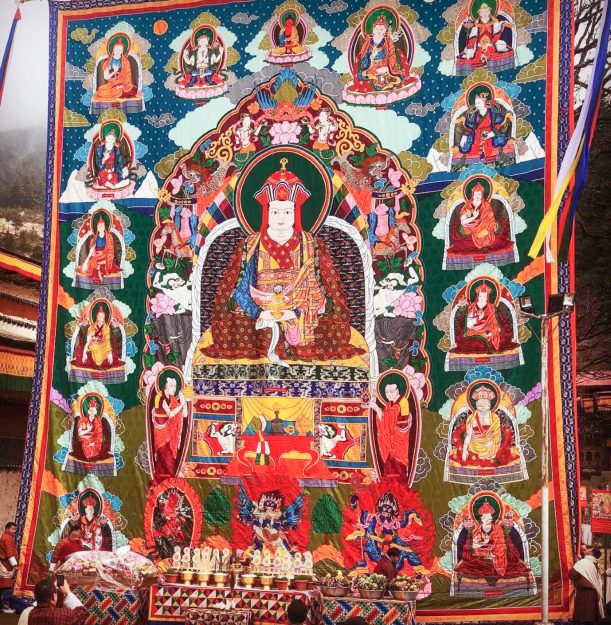
There were those who challenged Pema Lingpa’s authenticity, which led him to perform public revelations, including the famous underwater treasure extraction at Membar Tsho (Burning Lake), in which he carried a burning butter lamp that remained unextinguished while submerged. His influence was not limited to his locale. Pema Lingpa’s teachings impacted the greater Tibetan Vajrayana landscape, as evidenced by the inclusion of episodes from his life and practices on the murals within the Dalai Lamas’ private Lukhang Temple in Lhasa, Tibet. In an age when Tibet was the central source of Vajrayana knowledge and skill, Pema Lingpa was a sought-after spiritual resource and inspiration for many renowned lamas and leaders including the fifth and sixth Dalai Lamas and the seventh Karmapa─reversing the usual flow of spiritual information.
Pema Lingpa’s tercham (treasure dances) were typically revealed during dream or meditative states in which choreographic instructions were imparted to him. The dances are spiritual teachings, prayers, and rituals that form a seamless expression of “body, speech, and mind,” three doorways to enlightenment. They continue to be practiced in a line of uninterrupted transmission in many Buddhist establishments in Bhutan.
Tamzhing─The Temple of the Good Message
In 1501, Pema Lingpa began construction on the monastery known as Tamzhing in the district of Bumthang. The story is told that when Pema Lingpa was looking for a suitable location for his monastery, the earth spirits sent a miraculous pig to indicate the auspicious site and level the ground for its construction. Another version says that Pema Lingpa’s yidam (meditation deity), the female deity Vajravarahi, appeared in the form of a pig and presented him with the design for the monastery. It is further believed that the dakinis (female wisdom facilitators) laid the foundation wall and sculpted many of the interior statues.
Before the consecration of the temple, Pema Lingpa is said to have had a visionary dream in which Vajravarahi again appeared, this time performing a dance and telling him to learn it for the temple consecration ceremony. Upon awakening, he wrote down the steps, taught the dance to his disciples, and introduced Phag Cham (Dance of the Pig) at the temple’s consecration ceremony as an offering of gratitude to the pig. Every year the performance of this dance commemorates this providential event as it opens the Tamzhing Phala Choepa, or the Tamzhing Festival of the Pig.
Video courtesy the Pema Lingpa Foundation
The Fall 2020 Rollout
As this past fall approached, I waited expectantly for the rollout of the Bhutanese festivals, of which Tamzhing Phala Choepa is only one. The autumn calendar of religious festivals fell on the heels of a strict three-week national lockdown. From the outbreak of the pandemic, the monarchy, elected government, and central religious administration—Bhutan is a Vajrayana Buddhist country—had aligned in issuing strict COVID-19 measures restricting social gatherings. The festivals are annual community affairs that draw tightly packed crowds to the monasteries and temples for dramatic cham dances, community folk dances, and monks’ rituals and ceremonies─all held in the spirit of collective renewal and blessings.
As it turned out, the monasteries held the sacred festivals “behind closed doors,” respecting the government’s admonition against public gatherings. This meant that all the rituals and dances were performed by the monks of the hosting monasteries, but the public was not invited to attend. Now, this is not entirely unusual. Some dances and rituals are frequently unseen by the public and performed solely for an envisioned audience of enlightened beings. But this past year, national television, the newspapers, and each of the religious institutions holding the festivals streamed the proceedings for the benefit of all to see─even rituals and dances that are normally not open to the public. And just as online technology has opened so many events for global participation, I was able to take in four overlapping festivals, which would not have been possible in previous years.
***
A Few Highlights from Pema Lingpa’s Treasure Dances
The year before I had attended the Tamzhing Festival in person and beheld the bountiful dance legacy of Pema Lingpa performed there. My helpful guide for this three-day event was Lopon Phuntsho, the Discipline Master and former champon (cham dance master) of Tamzhing.
Within the Pema Lingpa, or Peling, tradition, there are both dances performed by monks and those performed by lay volunteers. The opening solo, Phag Cham, is usually danced by the lay champon (different from the monk champon). He wears the mask of a boar and carries a leafy weeping willow branch in each hand─sweeping and swirling them as he leaps about dancing to each of the four directions to sprinkle blessings. (The sprinkling was literal, as it was raining.) Incense filled the air with scent and smoke to purify the space for ritual activity. Phag Cham is unique to Tamzhing Monastery and not performed anywhere else in Bhutan, or, for that matter, the world.
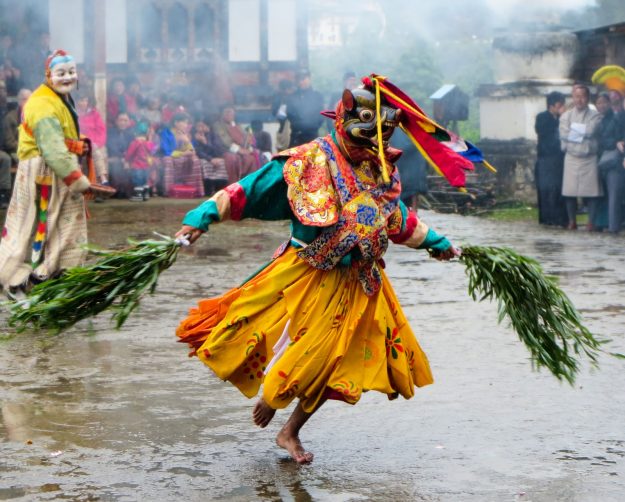
The lay champon, Pema Rigzin, shared that each household from three Bumthang villages is responsible for sending a volunteer to dance at the festival─either a male to perform the lay masked dances or a female to perform the folk dances. Pema Rigzin explained that they all begin rehearsing 20 days in advance. He had been performing these cham for 11 years.
When I asked if he looked forward to dancing at the festival each year, Pema Rigzin responded, “Because these dances are sacred, I will continue to perform them until I cannot.”
Tshering Pem, the leader of the female folk dancers, had been volunteering as a dancer for more than 20 years and had been inspired by her aunt, who had also danced. She offered that the group collectively decides which dances to perform and that each dancer is responsible for buying her own costume.
One of the most important Pema Lingpa tercham was only performed during the chamjug, or rehearsal. This Zhanag Cham (Black Hat Dance) called Phurbai Gi Tsacham was received in a visionary dream with instructions to include it in the rituals for the consecration of the Tamzhing Temple. When Pema Lingpa awoke from his dream, he wrote down the steps in a text called Phurba Soggi Pudri (Life Razor Kilaya Teaching). He connected the dance steps with the lines of the prayer to the wrathful deity Vajrakilaya. In this dance, according to Lopon Phuntsho, the champon recites the prayer-dance sequence as he dances, thus informing the dancers when to change steps. The dancers carry a phurba (three-bladed ritual dagger) in the right hand and a skull cup in the left. In public performances, they would wear the brocade monks’ robes and Tantric black hats.
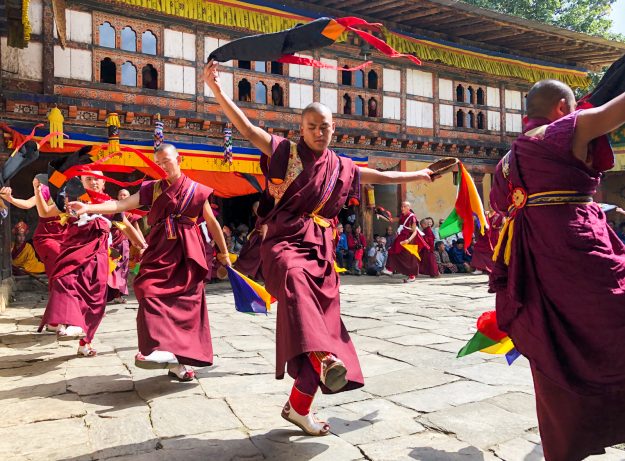
The most commonly performed Pema Lingpa tercham in Bhutan may be the trilogy of dances called Peling Ging Sum. These dances originated in the revealed text Lama Norbu Jamtsho from Mendo Cliff at Lhodrak in southeastern Tibet (just north of Bumthang). The text contains the instructions for the dances to be performed as part of a prayer cycle that is also included in the treasure text. The contents of this prayer are both chanted and danced and considered a means of identifying and subduing obstacles, as well as cultivating enlightenment. Although Peling Ging Sum is performed at festivals throughout the country, two different versions are performed at Tamzhing─a monks’ version and a laymen’s version.
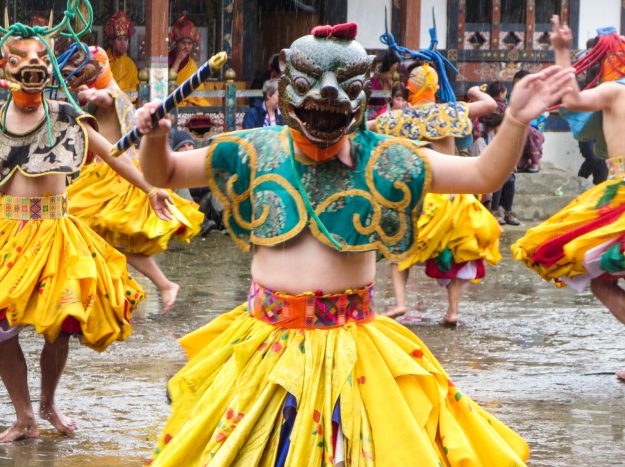
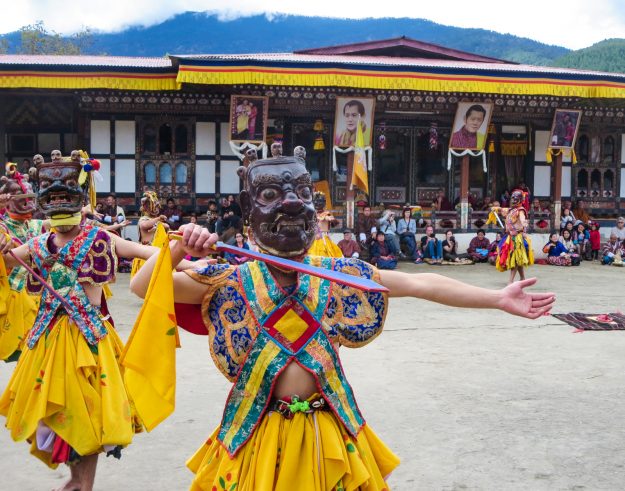
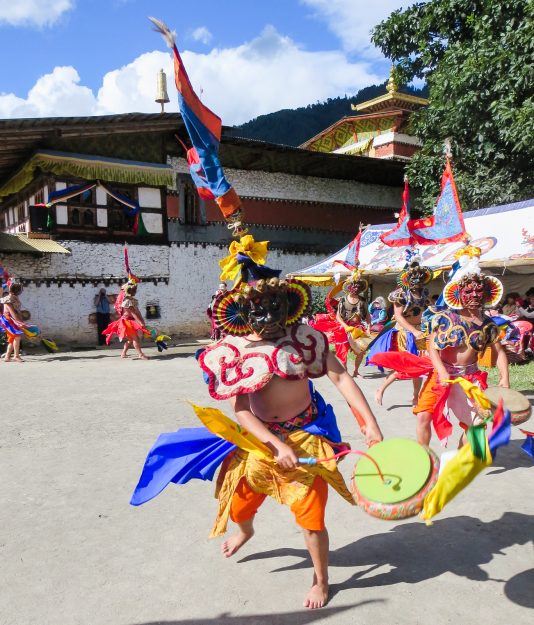
The two versions of Peling Ging Sum performed at Tamzhing bring up a significant story. The dance master Lopon Phuntsho explained that the lay dance tradition was danced by the local disciples of Pema Lingpa in Bumthang from the time of the consecration of Tamzhing. With Pema Lingpa’s frequent journeys to Lhodrak, Tibet, he was given the monastery of Lhalung as a base of operations there. The monks at Lhalung adopted and danced the Peling traditions as well. After the Chinese invasion of Tibet in 1959, some of the monks from Lhalung, including the umdze (chant master) and champon, made their way to Tamzhing. They brought with them the dance traditions they had practiced in Tibet. Today, both traditions are performed alternately during the festival, demonstrating the extraordinary richness of the Peling legacy.
The serene Khandroi Gar Cham (Dance of the Dakinis) is another tercham resulting from one of Pema Lingpa’s dance lessons with Yeshe Tsogyal during a visionary trip to Zangtopelri (The Copper-Colored Mountain Paradise of Padmasambhava). The dancing monks require some assistance from other monks and dancers in donning the elaborate dakini costumes with their layers of detail: colorful brocade robes, delicate aprons of bone ornaments, braided wigs, five lobed crowns, and the central topknot of enlightenment. They move slowly and mindfully in various formations while playing the damaru (small, double-sided hand-drum) with the right hand and ringing the drilbu (small bell) with the left. The sounds produced by these instruments are corresponding reminders of impermanence and emptiness. During the dance, dakini prayer cycles are recited by the monks.
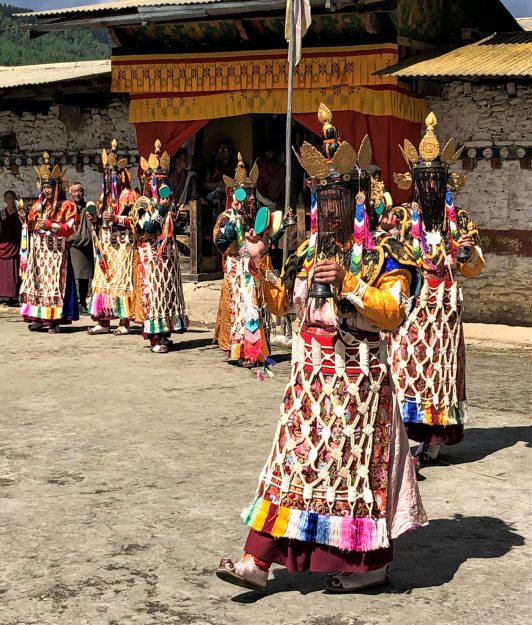
A delightful and unique Pema Lingpa treasure is Tshang Mai Ging Cham, sometimes called Tamzhing Tercham. Again, this dance is said to be the result of one of Pema Lingpa’s visionary encounters with Guru Padmasambhava and Yeshe Tsogyal, during which they taught him the steps. Twelve lay dancers perform this simple, folksy dance wearing yellow kerchief skirts, human-faced masks, and a white khata (ceremonial scarf) covering the top of their heads. One of the masks is said to be the craftwork of Pema Lingpa. When I asked if the champon wears it, I was told that more practical matters go into choosing who wears which mask. As the mask is quite small, it is worn by a dancer with a small head. The dancers carry and play a damaru with the right hand and ring the small drilbu with their left in simple repeated rhythms as they hop, turn, and step in various formations.
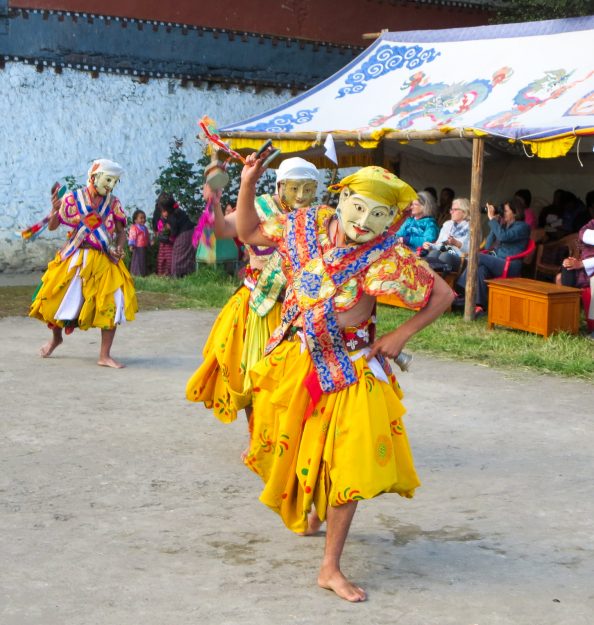
Periodically, the performers stop while two village leaders bring out khatas and money given by family and friends to show appreciation to the dance volunteers. The village leaders approach the chosen dancers and tie the offered khata across their torso. Meanwhile, the dancer’s wife or mother usually accepts and holds the monetary offerings as the dance recommences. By the end, so many white scarves have accumulated around the dancers’ midriffs that they appear quite transformed. The spontaneous elements of the dance make it a veritable love fest.
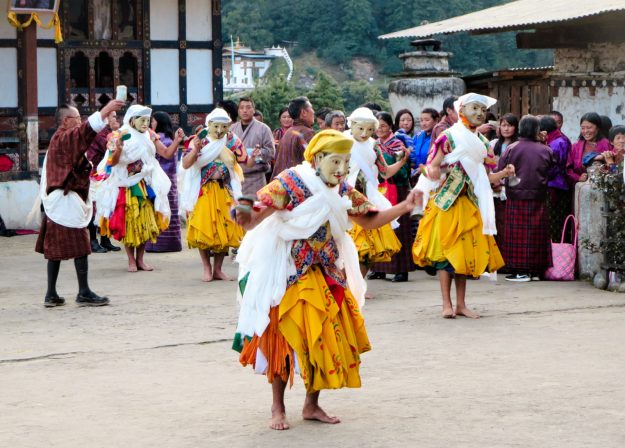
The festival at Tamzhing ends in a grand tradition called Uday Wang, which celebrates the manifestation of the local deity Tseo Marpo, including his adoration by and blessings upon the community. Initially, five monks perform a slow and somber welcome dance for Tseo Marpo. Next, masked dancers process with the deity with pomp and musical fanfare to his throne for offerings of dance, music, incense, oblations, and a white ceremonial scarf. The local villagers perform prostrations and form a line to receive blessings from their local deity that assure a state of purification. With this final expression of community identity and local custom, the Tamzhing Phala Choepa concludes, leaving everyone sated with age-old traditions and the promise of blessings for the coming year.
Thank you for subscribing to Tricycle! As a nonprofit, we depend on readers like you to keep Buddhist teachings and practices widely available.
